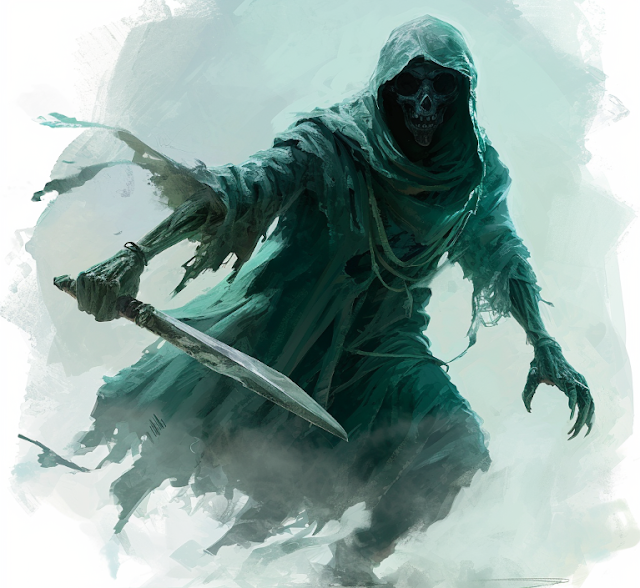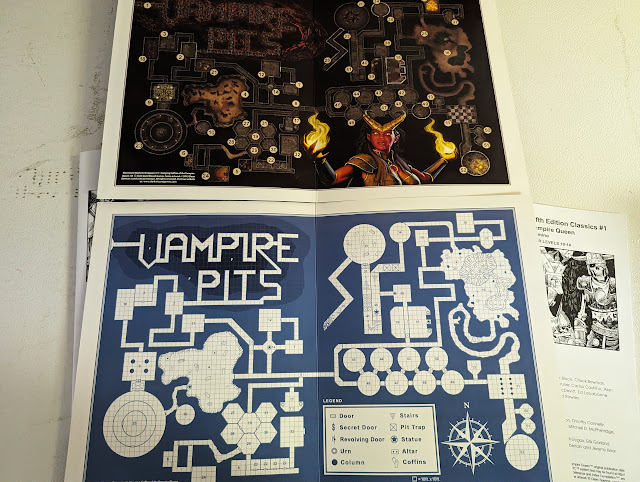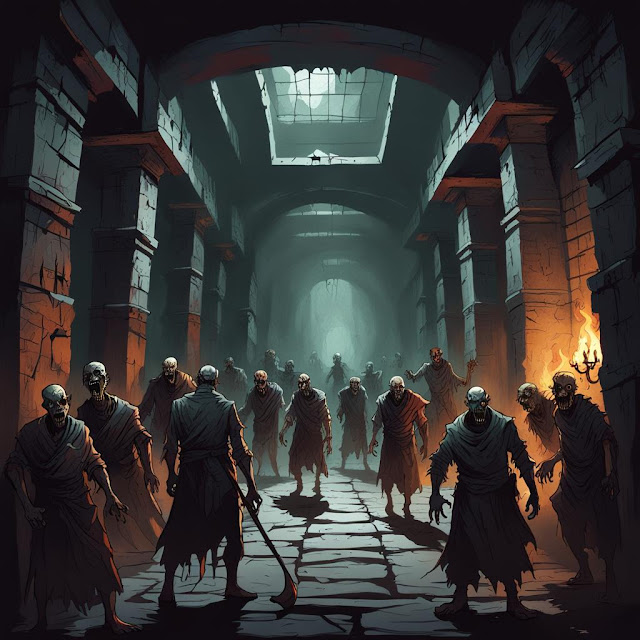[Fanzine Focus XXXIII] Tales from the Smoking Wyrm No. 1
 On the tail of Old School Renaissance has come another movement—the rise of the fanzine. Although the fanzine—a nonprofessional and nonofficial publication produced by fans of a particular cultural phenomenon, got its start in Science Fiction fandom, in the gaming hobby it first started with Chess and Diplomacy fanzines before finding fertile ground in the roleplaying hobby in the 1970s. Here these amateurish publications allowed the hobby a public space for two things. First, they were somewhere that the hobby could voice opinions and ideas that lay outside those of a game’s publisher. Second, in the Golden Age of roleplaying when the Dungeon Masters were expected to create their own settings and adventures, they also provided a rough and ready source of support for the game of your choice. Many also served as vehicles for the fanzine editor’s house campaign and thus they showcased how another DM and group played said game. This would often change over time if a fanzine accepted submissions. Initially, fanzines were primarily dedicated to the big three RPGs of the 1970s—Dungeons & Dragons, RuneQuest, and Traveller—but fanzines have appeared dedicated to other RPGs since, some of which helped keep a game popular in the face of no official support.Since 2008 with the publication of Fight On #1, the Old School Renaissance has had its own fanzines. The advantage of the Old School Renaissance is that the various Retroclones draw from the same source and thus one Dungeons & Dragons-style RPG is compatible with another. This means that the contents of one fanzine will be compatible with the Retroclone that you already run and play even if not specifically written for it. Labyrinth Lord and Lamentations of the Flame Princess Weird Fantasy Roleplay have proved to be popular choices to base fanzines around, as has Swords & Wizardry and the Dungeon Crawl Classics Roleplaying Game from Goodman Games.
On the tail of Old School Renaissance has come another movement—the rise of the fanzine. Although the fanzine—a nonprofessional and nonofficial publication produced by fans of a particular cultural phenomenon, got its start in Science Fiction fandom, in the gaming hobby it first started with Chess and Diplomacy fanzines before finding fertile ground in the roleplaying hobby in the 1970s. Here these amateurish publications allowed the hobby a public space for two things. First, they were somewhere that the hobby could voice opinions and ideas that lay outside those of a game’s publisher. Second, in the Golden Age of roleplaying when the Dungeon Masters were expected to create their own settings and adventures, they also provided a rough and ready source of support for the game of your choice. Many also served as vehicles for the fanzine editor’s house campaign and thus they showcased how another DM and group played said game. This would often change over time if a fanzine accepted submissions. Initially, fanzines were primarily dedicated to the big three RPGs of the 1970s—Dungeons & Dragons, RuneQuest, and Traveller—but fanzines have appeared dedicated to other RPGs since, some of which helped keep a game popular in the face of no official support.Since 2008 with the publication of Fight On #1, the Old School Renaissance has had its own fanzines. The advantage of the Old School Renaissance is that the various Retroclones draw from the same source and thus one Dungeons & Dragons-style RPG is compatible with another. This means that the contents of one fanzine will be compatible with the Retroclone that you already run and play even if not specifically written for it. Labyrinth Lord and Lamentations of the Flame Princess Weird Fantasy Roleplay have proved to be popular choices to base fanzines around, as has Swords & Wizardry and the Dungeon Crawl Classics Roleplaying Game from Goodman Games.Tales from the Smoking Wyrm No. 1 is a fine-looking fanzine which provides long-term support rather than immediate support for use with the Dungeon Crawl Classics Roleplaying Game. This is not say that none of its content is not of use or even useless, for that is very much not the case, but rather that it requires a bit of effort upon the part of Judge to work it into her campaign. In fact, all of content is detailed, interesting, and worth reading. Published by Blind Visionary Publications in 2020, following a successful Kickstarter campaign, Tales from the Smoking Wyrm No. 1 also strays into the territory of the Mutant Crawl Classics Roleplaying Game – Triumph & Technology Won by Mutants & Magic, if only a little. In the main, Tales from the Smoking Wyrm No. 1 is very much a fanzine for Dungeon Crawl Classics.
Tales from the Smoking Wyrm No. 1 opens with ‘The Paladin’. What this does not do is introduce the Paladin as a Class for Dungeon Crawl Classics. Instead, it presents a means by which any other Class—though ideally a martial one—takes on the role and responsibilities of the Paladin. The article though, begins with a history of the role and Class in fantasy and fantasy roleplaying, from its origins in Supplement I – Greyhawk, all the way up to The Gongfarmers Almanac 2017 and DCC Annual, along the way taking in Poul Anderson’s Three Hearts and Three Lions and Elizabeth Moon’s The Deed of Paksenarrion and Legend of Paksenarrion. It is nicely done, pleasingly informative, providing plenty of background and context before it details the Third Level Spell, Investiture, which is cast upon the candidate, who if it is successful, gains limited Cleric Class abilities, including Lay on Hands, Invoke Deity, and Turn Unholy. Invoke Deity is a spell-like effect which can grant the Paladin greater protection or even enable him to unleash blasts of divine power. Included also is a table of Investiture Trials that the potential Paladin must undertake. What this does is open up the possibility of a Player Character taking up a stronger religious role in a campaign setting other than already suggested by the Cleric Class and is nicely done.
The fanzine takes a darker turn with the inclusion of ‘Cthulhu’ as a Patron. Like any Patron for Dungeon Crawl Classics, this includes a table of Patron Results, which are fantastically invocative. For example, a pale emerald mote appears and emanates a glow surrounding the Invoker and everyone nearby, the invoker designating a target within range, who is grabbed by several tentacles as a sacrifice. The invoker gains a bonus to his next spell check and multiple targets can be designated to gain a bigger bonus. Unfortunately, using this inflicts patron taint upon the invoker, and there is a table for that and the effects of Spellburn, most of which involves taking on the cast and form of Great Cthulhu himself. To this are added the spells, Summons of the Deep, which summons bands of Deep Ones, Breath of the Deep, which inflicts drowning upon targets (or the ability to breath water upon a willing target), and Form of the Deep, which if successful, grants insights into the mind of Cthulhu himself. Cthulhu as a Patron should not necessarily work, the possibility being that the Elder God be reduced to window dressing and little in the way of flavour, but ‘Cthulhu’ invokes a sense of dread in worshipping him and enforcing the fact that doing so is not always beneficial and even it is, has its downside. This is nicely judged between its flavour and its effect and would make a great addition for an NPC cultist or in a really eldritch campaign for the Player Character Cleric. The inclusion of two extra ‘Appendix N Suggestions’ is an added bonus.
‘Cullpepper’s Herbal’ is the first in a regular feature in issues of Tales from the Smoking Wyrm. In game, it consists of the notes of famed herbalist, Willhomeena Cullpepper, whose bibliography is given too. Two herbs—Aconite and Adder’s False Tongue—are described in no little detail, including uses that the parts can be put to, including means of healing and poisoning. There is a lot here to research and use, but the level of detail requires work to include it in a campaign. For the herbalist Player Character or the Player Character in need a cure though, this is useful content.
Tales from the Smoking Wyrm No. 1 takes a weirder turn with ‘The Silver Ball’. This is a device, a floating silver ball, invulnerable to almost all forms of damage, that just appears in a dungeon and absorbs a Player Character. It may or it may not return the Player Character, but the likelihood is that he will be changed when returned. There are tables for strange memories and physical changes, as well as surprising items which might be ejected from the Silver Ball. It can be used as a random encounter, a way to account for a player not being present at a session, or even a way to deliver a new Player Character deep into an adventure when no other method makes sense. As a recurring motif, even though its effects upon play are often humorous, the players and their character could come to hate it as it seems to appear at odd times, haunting their adventures, and so on… Almost equally as odd is the addition of the ‘Telepathic rat’, which is drawn from Mutant Crawl Classics. There is even a chance that the one that latches onto a Player Character is actually a miniature Giant Space Hamster, but all have a quirk and a minor special ability that can benefit the Player Character and possibly the rest of the party too, such as the urge to groom all of the party members, who if they accept it, gain a bonus Hit Point back when resting due to the lack of vermin infesting both them and their clothing.
‘Rites & Rituals Part I’ expands upon the use of magic and rituals in Dungeon Crawl Classics. The primary way in which a ritual differs from a spell is that it has its own action die rather than using the spellcaster’s. This can then be modified by using circles of both casters and followers, sacrifices, rare ingredients, accepting Corruption, and so on. This is simple and straightforward, but the two sample rituals—Rites of Schlag-Ruthe, which creates a dowsing device for magical sources of power and Dark Phylactory, which creates one or more vessels to protect the caster’s soul though at the cost of corruption—are detailed and complex, but add to play rather than impede it. That said, Dark Phylactory is in general, better suited to use by an NPC, whereas a Player Character can use Rites of Schlag-Ruthe as well as an NPC. Either way, the elements required by the spellcaster to perform a ritual will add to play, whether that is the Player Character collecting them or the Player Characters tracking an NPC who is collecting them to their own ends.
Joel Philips’ ‘Onward Retainer’ is a classic comic strip about the retainer in the fantasy roleplaying games. It is nicely drawn and touches upon several well-known jokes about that style of play. Although not too original, it is nevertheless amusing.
Penultimately, ‘What is the Smoking Wyrm?’ is the belated editorial in the first issue of Tales from the Smoking Wyrm No. 1. It provides a potted history of roleplaying and roleplaying games, which flits around a bit, but basically makes the point that the fanzine builds on what has before, comparing the flowering of the fanzine in the twenty tens within the Old School Renaissance and since the publication of Dungeon Crawl Classics, with that seen in the late nineteen seventies following the publication of Dungeons & Dragons. This is a fair point, but the editorial is lengthy and overwritten in comparison to the rest of the fanzine, making it feel self-indulgent if only a little. Lastly, ‘Wyrm Words’ is a crossword puzzle of Gygaxian words.
Physically, bar the editorial, Tales from the Smoking Wyrm No. 1 is well written and the fanzine as a whole, has high production values. The artwork is good throughout, and the front cover echoes the illustration from the Dungeon Master’s Guide for Advanced Dungeons & Dragons, First Edition, by Dave Trampier, which is based on the Street of the Knights on the Greek island of Rhodes. This is an illustration that the fanzine will return to again and again for its front covers.
Tales from the Smoking Wyrm No. 1 is a solid first issue. It has some excellent content, but this is content that will have to be worked into a campaign, rather than simply added and brought into play immediately. For the Judge that wants to add depth to her Dungeon Crawl Classics game, Tales from the Smoking Wyrm No. 1 has material that will help her do that.















.jpg)












